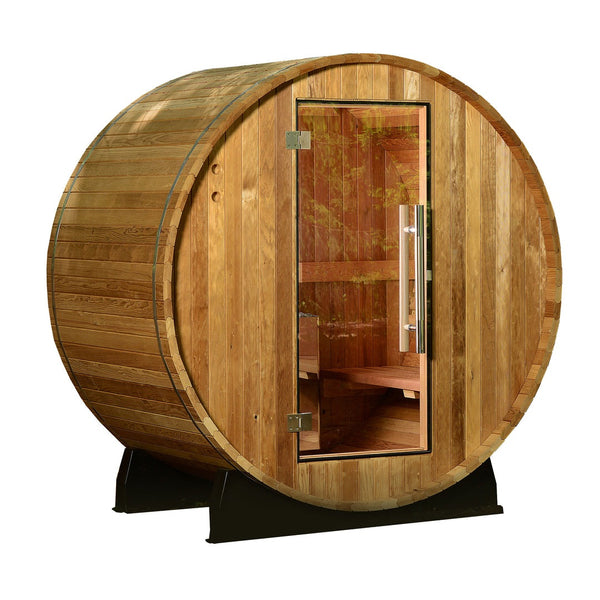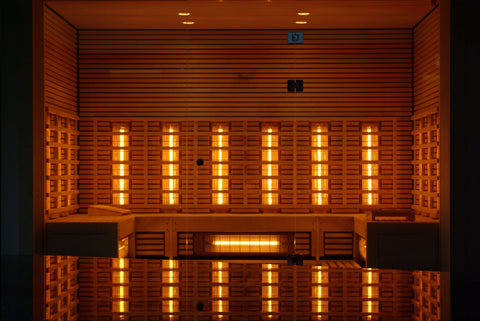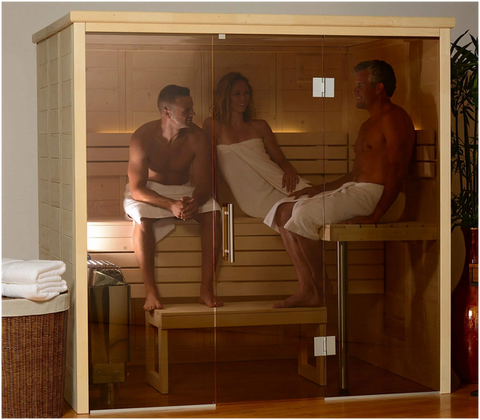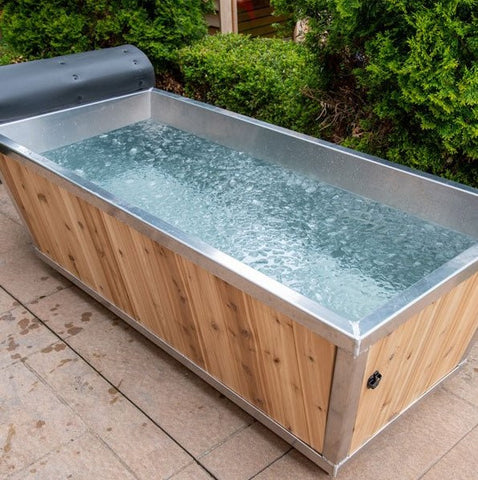Are you wondering whether infrared saunas are safe for you? You’re right to be concerned, but the real dangers might not be what you expect.
Remember the bliss of basking in the sun, soaking in the warmth and feeling it permeate your skin and body? Infrared saunas work in a similar fashion, using infrared waves to heat up your body from the inside out. Used correctly, infrared saunas can be as safe as sunbathing.
However, infrared saunas have some risks. Poor construction, excessive use, or certain health conditions can make them problematic. Potential dangers include:
-
Eye strain or retinal damage (especially for those with light sensitivity)
-
Heat stress and dehydration from prolonged exposure
-
Worsening of conditions like heart disease, kidney disease, or MS
-
Negative effects on implants and metal plates, including pacemakers
-
EMF and ELF exposure (a common concern with electrical devices)
-
Low blood pressure, leading to dizziness or fainting
-
Skin reactions, such as heat rash or burns
-
Detox symptoms, like headaches, nausea, or fatigue
Poorly constructed saunas can also have issues with VOC off-gassing, uneven heat distribution, toxic materials in wiring and insulation, and fire hazards. Most of these risks can be minimized by buying high-quality saunas and using your infrared saunas appropriately.
Most of these risks are not unique to infrared saunas, and we’ve already covered the general benefits and risks of sauna use in a previous post. Here, we’ll explore the dangers of infrared heat so you can enjoy your infrared sauna without worry.
Dangers of Infrared Heat (+ How to Safely Enjoy Its Benefits)
Unlike traditional Finnish saunas which heat the air around you using steam, infrared saunas produce dry heat by converting electricity into infrared waves. These waves penetrate the skin, warming the body directly rather than heating the surrounding air.
Infrared heat is divided into three categories based on wavelength:
Near-Infrared (NIR): Deep Penetration But Highest Risk
Infrared light is a type of electromagnetic radiation with wavelengths ranging between 760 nanometers (nm) and 1 millimeter (mm). Near-infrared (NIR) light has the shortest wavelengths within this range, sitting between 700 nm and 1400 nm. That’s just beyond visible red light, hence the name.
Near infrared light penetrates deeper into the skin and tissues than other infrared types, reaching up to 5 mm inside the body. That makes it particularly useful for deep healing and therapy.
NIR is used in medical therapies, including red light therapy for mood and sleep improvement, wound healing and muscle recovery, anti-aging therapy through increased collagen production, and treatment of some neurodegenerative conditions.
owever, excessive exposure may strain the eyes or cause oxidative stress. Unlike mid- and far-infrared, NIR produces little heat, focusing more on biological stimulation rather than deep warming effects.
Prolonged exposure to short wavelength NIR radiation is known to harm workers in various industries, particularly glass and steel production, according to ICNIRP 2020 guidelines. Studies suggest prolonged exposure can cause cataracts, accelerated skin aging, skin burns, heat stress, and increased risk of skin cancer related to skin damage.
Mid-Infrared (MIR): Best for Inflammation, Pain Relief, and Circulation
Mid-infrared (MIR) light is 1,400 nm–3,000 nm in wavelength, sitting between near-infrared and far-infrared on the spectrum. It penetrates moderately deep into the body (1–3mm), reaching muscles, joints, and soft tissues.
MIR is believed to improve circulation, reduce inflammation, and relieve pain, making it popular for muscle recovery and arthritis relief. That’s because, unlike NIR, MIR produces more noticeable heat, helping to stimulate blood flow and promote sweating.
Some studies suggest that MIR can also help reduce cognitive decline and improve gut bacteria populations.
However, excessive exposure can lead to heat stress, dehydration, or dizziness. MIR is often combined with far-infrared in full-spectrum infrared saunas to provide a balance of deep tissue benefits and detoxification.
Far-Infrared (FIR): Best and Safest for Infrared Saunas
When it comes to infrared saunas, the far-infrared (FIR) part of the spectrum is probably the best and most important. Many infrared saunas are designed to only emit FIR heat to attract users who have concerns with NIR and associated risks.
Far-infrared (FIR) light lies between 3,000 nm and 1 mm on the electromagnetic spectrum and is the most commonly used type in infrared saunas. It penetrates less than 1 mm into the body but generates intense heat, warming you from the inside out.
Far-infrared (FIR) is crucial in human and animal biology because it is readily absorbed by water molecules and body tissues. It induces vibration and resonance in water molecules, leading to internal heat generation and deep thermal effects.
This unique property gives FIR many health benefits, such as the ability to stimulate circulation, enhance oxygen delivery, and promote detoxification through sweating. It also supports cellular function, muscle relaxation, and pain relief thanks to its deeper warming effect.
Because biological tissues naturally absorb FIR, it plays a vital role in thermoregulation, metabolism, and overall well-being in both humans and animals.
However, excessive exposure to far infrared heat can lead to dehydration, dizziness, low blood pressure, or heat exhaustion. It’s worth noting that the risk of excessive heat exposure is common to all saunas, particularly wood-burning saunas which have less precise temperature control compared to infrared saunas.
Some FIR sauna systems also raise concerns about EMF exposure, though high-quality models are designed to minimize this risk. FIR is valued for its deep, soothing warmth and potential health benefits.
Can Infrared Saunas Cause Cancer?
Many people today have an unfounded fear of anything with the word "radiation" attached to it, but the truth is infrared saunas don’t cause cancer.
Here’s why: infrared radiation is non-ionizing, meaning it doesn’t have the energy to damage DNA or mutate cells like UV rays, X-rays, or gamma radiation. In fact, infrared light is the same type of heat your own body emits and is even used in medical therapies, baby incubators, and physical rehabilitation.
But we said NIR radiation can lead to cancer among glass and steel factory workers, so what’s the deal with that?
The difference lies in intensity and exposure. In industrial settings, workers are exposed to high doses of infrared radiation for long periods, often with little protection. Although IR radiation is non-ionising, prolonged exposure can damage the skin and body organs. Additionally, radiation in industries isn’t limited to infrared and usually includes some UV radiation as well.
This kind of prolonged, concentrated exposure can be harmful, especially when combined with other workplace hazards. It’s no different to the risks of sun exposure. If you spend all day, everyday out in the sun without protection, eventually the UV rays will get to you.
In contrast, infrared saunas are designed for short, controlled sessions with far lower levels of infrared radiation. So while it’s true that excessive exposure to high-intensity NIR can be risky, the exposure you get in a sauna is far less intense and much safer.
That said, there are a few concerns we must address here.
1. EMF Exposure: Cause for Concern?
Some infrared saunas emit low levels of electromagnetic fields (EMFs) due to their electrical components, as does your microwave, fridge, TV, mobile phone, and Wi-Fi router.
There’s a lot of misunderstanding regarding the risks of EM fields. Firstly, EM radiation is a very broad term, and it’s wrong to say that all EM radiation is dangerous.
In fact, energy from the sun reaches us in the form of electromagnetic waves. Visible light is part of the EM spectrum. Medical equipment like X-rays and CT-scans use EM radiation for diagnostics. Mobile phones, Wi-Fi, FM radio, and radar all use EMFs.
|
Type of Radiation |
Wavelength Range |
Frequency Range |
Applications |
|
Radio waves |
>1 mm (1 mm – 100 km) |
<300 GHz |
Broadcasting (AM/FM, TV), Wi-Fi, Cell Phones |
|
Microwaves |
1 mm – 1 cm |
300 GHz – 30 GHz |
Microwave Ovens, Radar, GPS, Satellite Communications |
|
Infrared (IR) |
700 nm – 1 mm |
430 THz – 300 GHz |
Infrared Saunas, Night Vision, Remote Controls, Heat Lamps |
|
Visible Light |
400 nm – 700 nm |
750 THz – 430 THz |
Human Vision, Photography, Fiber Optics |
|
Ultraviolet (UV) |
10 nm – 400 nm |
30 PHz – 750 THz |
Tanning, Sterilization, Black Lights, UV Therapy |
|
X-Rays |
0.01 nm – 10 nm |
30 EHz – 30 PHz |
Medical Imaging, Airport Security, Cancer Treatment |
|
Gamma Rays |
<0.01 nm |
>30 EHz |
Nuclear Reactions, Cancer Therapy, Space Observations |
It’s more technically correct to say that high-energy, ionizing radiation causes cancer. Ionizing radiation is very high energy radiation that has enough energy to remove electrons from atoms, which can damage DNA and lead to cell mutations.
This type of radiation includes UV rays, X-rays, and gamma rays, all of which have the potential to cause cancer if exposure is prolonged or intense enough. On the other hand, infrared radiation (including that from infrared saunas) is non-ionizing. It doesn’t have enough energy to remove electrons or directly damage DNA and poses no direct cancer risk.
Scientific studies to-date haven’t shown any strong correlation between low-energy EMFs and cancer. Some indirect links may be drawn, particularly since strong EM fields can interfere with hormone production. For example, they can cause reduced melatonin production, which in turn can result in increased risk of developing cancer.
Melatonin is thought to help prevent the development of tumors, and studies have shown that cancer patients tend to have lower melatonin levels.
The truth is, extensive studies on the biological effects of electromagnetic waves are sparse, which is why prudent people prefer to buy low-EMF saunas just to be safe.
Here are Select Saunas, we work with the most reputable sauna manufacturers to bring you a wide range of low and near-zero EMF saunas. Here are two of our best-selling Low-EMF Far-Infrared Saunas that use Ultra Low EMF Heat Emitters and shielding technology.
|
Dynamic Saunas Avila Elite 1-2 Person Ultra-Low EMF FAR Infrared Sauna |
Maxxus 2-Person Full-Spectrum Near-Zero EMF FAR Infrared Sauna |
|
|
|
2. Extremely Low Frequency Fields (ELFs)
Electromagnetic fields consist of coupled magnetic and electric components, but sometimes the two components act independently. Extremely low frequency (ELF) fields are electric fields with a frequency of 1–300 Hertz and are usually generated by power lines, many electric appliances, and electrical wiring.
These low-frequency, low-energy waves do not directly cause cancer, and studies at high-powered ELF levels in mice have not shown any biological impact. Concerns with ELFs arose from people living near high-voltage power lines, which typically produce strong magnetic and ELF fields, but even these aren’t known to cause an increased risk of cancer.
Thus, there is no known scientific basis for worrying about ELFs in your infrared sauna, especially given the negligible exposure levels for the average sauna user.
3. Overheating & Oxidative Stress
Prolonged exposure to extreme heat can cause oxidative stress, which is linked to inflammation—an underlying factor in many diseases, including cancer.
However, this is more about excessive heat exposure than infrared in particular. Oxidative stress refers to an imbalance in the production of free radicals and the body’s natural ability to neutralize them with antioxidants. The link between oxidative stress, inflammation, and cancer has been well studied, and you should avoid excessive heat exposure of any kind.
Use your infrared, electric, or wood-fired sauna in moderation (15-45 minutes per session, depending on your tolerance) and stay hydrated. Take time to cool down between sessions, and you will be fine.
Note: Maintaining a safe sauna temperature is vital to help keep yourself and your loved ones safe. Here’s our detailed temperature guide for all types saunas.
3. Skin Sensitivity, Eye Sensitivity & Other Preexisting Conditions
If you suffer from or have a high risk of developing conditions such as heart disease, skin problems, eye sensitivity, and weak immune system, talk to your doctor before using an infrared sauna or any other sauna.
While infrared heat isn’t linked to skin cancer like UV rays, excessive heat exposure might irritate sensitive skin, cause heat stress to the body, and worsen underlying conditions.
Even if you’re generally healthy and active, we recommend that you talk to your doctor about using infrared sauna therapy for your safety.
Verdict: Are Infrared Saunas Dangerous?
Infrared saunas are not inherently dangerous—in fact, they offer a range of potential health benefits, from improved circulation to muscle relaxation and detoxification. Unlike ionizing radiation (UV rays, X-rays, gamma rays), infrared radiation does not damage DNA or increase cancer risk.
However, safety depends on proper use and sauna quality. Low-quality saunas may pose risks such as VOC off-gassing, high EMF exposure, and poor heat distribution. When buying an infrared sauna, we recommend talking to experts in the field for guidance and help with choosing a model with good quality materials, workmanship, and low-EMF components.
Here at Select Saunas, we’re at your disposal to help you find a safe infrared sauna to suit your needs. Whether you’re looking for a 2 person sauna to unwind with a partner, or a larger 6+ person sauna to socialise with friends, we’ve got you covered. Talk to us today and we’ll help you avoid the dangers of infrared saunas.











































































































